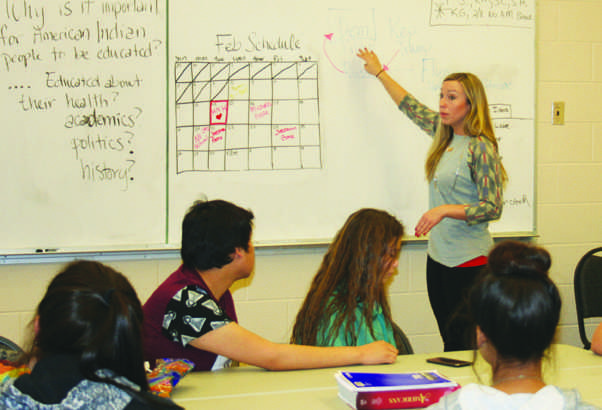The Immersion Factor: Native students absorb culture alongside math and social studies in immersion program
Photo by Mackenzie George
Jordann Lankford debriefs students in the immersion program following CNN10, the daily newscast.
February 23, 2017
Sophomore Mackenzie Mann spent both years at C.M. Russell before becoming a part of the interTRIBAL Immersion School at Paris Gibson. The program, in the midst of its pilot year, was kickstarted by CMR graduate and Indian Education Coordinator Jordann Lankford as well as administration such as associate superintendent Tom Moore and Indian Education Department Leader Corey Smith. Lankford describes the program as “part of Great Falls’ bigger picture of ensuring all students are provided with a meaningful education that will also increase graduation rates and prepare students for college and careers.”
Before, Mann had difficulty getting to school or class, but now, “it’s enjoyable to be here,” she said.
“We’re more of a family. It’s not like normal classes, how there’s kids you don’t talk to and stuff. We all just talk. All of us know each other really well,” she said.
The immersion program originally ran from 9 a.m. to 1 p.m. each day. Now that the students are acclimated, they spend from 9-11:45 with Lankford before taking lunch and attending regular classes for the remainder of the day. Immersion students study math, English, social studies, and science, but Native culture is incorporated into every activity.
Attendance — rather, a lack thereof — had a large part in the institution of the immersion program.
“For whatever reason, this year we had chronically absent students immediately,” Lankford said.
Normally, dropouts rise during second semester, as students realize after failing classes first semester that they won’t have enough credits to move up a grade, Lankford explained. This year, though, dropouts and chronic absences (30 or more by October) were an issue almost immediately, leading to Lankford and administration coming up with the immersion program.
“The thing about dropping out of school is that when you drop out of school you don’t just disappear. You’re still a part of society, but for the most part in a very negative way because you don’t have the job skills or resources to get a well paid job, so you turn to other things like crime and stuff like that as a means to survive,” Lankford explained. “We want as many students as possible to graduate with the job skills or college-bound skills to be successful in life.”
Part of the problem, Lankford added, was transportation. Many students didn’t drive, and their parents couldn’t — or wouldn’t — take them to school. The immersion program includes rides to and from Paris Gibson Education Center.
The other issue was that students weren’t engaging in school because they weren’t interested in the material.
“The students were either uncomfortable with the schools they were in or they weren’t interested in the material that they were learning, so we wanted to make it more relevant to them in their lives. And we decided to come up with a place where culture is emphasized because these native students get it in their homes a lot and in their family units,” Lankford explained.
Sophomore Jason Denent appreciates the new environment.
“I like the extra help we get, and I like how the teachers take it slow and ask questions instead of just throwing a packet out in front of you,” Denent said. “We made tipis and we do a lot of creative stuff.”
Mann said the students watch CNN 10, a 10-minute news program, each morning to “learn about the daily stuff that happens in our world.” Then they construct short responses regarding current events followed by an activity or a visit from the math teacher. They also plan events. Most recently, the immersion students were in charge of helping plan Healthy Young Native Hearts, a Valentine’s Day luncheon addressing heart disease, the leading cause of death in Native women.
Planning events is sophomore Kaylee Gallagher’s favorite part of the program.
“I enjoy [the immersion program] because it’s more helpful than what I’ve done before. I didn’t really go to school at all,” Gallagher said.
Gallagher plans on becoming a therapist. Mann wants to become a certified nursing assistant. Denent is going to join a family business. They all have different career paths in mind, but for now they can all agree on one thing — they appreciate Lankford.
“Everybody has a great relationship with her,” Gallagher said. “We are really close.”
“Ms. Jordann, she’s just like an outgoing person,” Denent said. “She makes the class laugh and want to do the [work].”
“She’s like my favorite person in the world. She’s really open; you can tell her anything. She’s like a motherly figure in my life,” Mann explained.
Lankford understands the impact that the program has on its students.
“We don’t want anyone to go to school and hate being in school. We want them to know, ‘This is why you’re learning this, this is how it applies to you, and this is how you can use it later,’” Lankford said. “We’re not saying that only Native kids deserve something like that. We think every student in Great Falls Public schools, or anywhere, deserves to have a relevant, meaningful education. Because that’s what’s going to prepare you for the rest of your life, is the stuff that you’re engaged in.”
Drew Uecker, Paris Gibson’s principal, agrees.
“We made the academics relevant to their culture to give them a diploma that matters,” he said.



